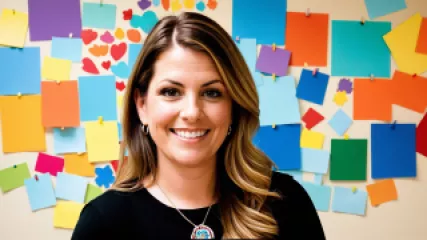Empowering Special Needs Educators: An Interview with an Experienced Teacher
Empowering Special Needs Educators: An Interview with an Experienced Teacher
In the ever-evolving landscape of education, the role of special needs educators has become increasingly critical. These dedicated professionals are the champions of inclusivity, working tirelessly to ensure that every student, regardless of their unique challenges, receives the support and tools they need to thrive. Today, we have the privilege of sitting down with Brooke Sullivan, a seasoned special education teacher, to delve into the heart of this vital field and uncover the insights that can empower both new and experienced educators alike.
The Journey to Becoming a Special Needs Educator
Brooke's path to special education was not a straight and narrow one, but rather a journey of self-discovery and a deep passion for making a difference. "I always knew I wanted to work with children," she reflects, "but it wasn't until I had the opportunity to volunteer in a special needs classroom that I found my true calling."
Brooke's eyes light up as she recounts her first experiences working with students who faced unique challenges. "There was something so incredibly rewarding about seeing the 'light bulb' moments, when a concept that had once seemed elusive finally clicked. It was in those moments that I realized the profound impact an educator can have, not just on academic progress, but on a child's self-confidence and sense of worth."
Driven by this revelation, Brooke pursued her degree in special education, eager to hone her skills and deepen her understanding of the diverse needs of her future students. "The coursework was intense, but it was also incredibly eye-opening," she explains. "We delved into the latest research, explored cutting-edge teaching methodologies, and learned how to create personalized learning plans that truly cater to each student's individual strengths and challenges."
Navigating the Unique Challenges of Special Education
As Brooke embarked on her teaching career, she quickly realized that the reality of special education was both incredibly rewarding and inherently complex. "Every day is a new adventure," she admits with a smile. "One moment, you might be celebrating a major breakthrough with a student, and the next, you're problem-solving through a challenging behavioral issue. It's a delicate balance of academic instruction, social-emotional support, and unwavering patience."
Brooke emphasizes the importance of building strong relationships with her students and their families. "Special education is truly a collaborative effort," she explains. "We work closely with parents, therapists, and other support staff to ensure that we're all on the same page and providing a cohesive, nurturing environment for the child to thrive."
Navigating the ever-changing landscape of educational policies and funding can also present its own set of challenges. "It's crucial that we stay up-to-date on the latest regulations and best practices, while also advocating for the resources our students need," Brooke says. "Sometimes, that means getting creative with our teaching methods or finding innovative ways to supplement our classrooms. But it's all worth it when we see the progress our students make."
Strategies for Empowering Special Needs Educators
When asked about the key strategies that empower special needs educators, Brooke offers a wealth of insights. "First and foremost, it's essential that we maintain a growth mindset," she emphasizes. "Our students face unique obstacles, but with the right support and strategies, they are more than capable of achieving their goals. As educators, we need to approach each challenge with a sense of optimism and a willingness to adapt our methods to meet their needs."
Brooke also stresses the importance of ongoing professional development. "Special education is a constantly evolving field, and we have a responsibility to stay informed about the latest research, evidence-based practices, and emerging technologies that can enhance our teaching. Attending workshops, collaborating with colleagues, and seeking out mentorship opportunities can be invaluable in keeping our skills sharp and our passion for the work alive."
Another crucial element, according to Brooke, is the cultivation of a supportive school community. "Special education teachers can't do it all alone," she explains. "We need the backing of our administrators, the understanding of our general education counterparts, and the empathy of the broader school community. When everyone works together to create an inclusive, nurturing environment, it empowers us to truly make a difference in the lives of our students."
Advice for Aspiring Special Needs Educators
For those considering a career in special education, Brooke has a wealth of wisdom to share. "First and foremost, this work requires a deep well of empathy, patience, and resilience," she cautions. "You'll face challenges that can be physically and emotionally draining, but the rewards far outweigh the difficulties."
Brooke encourages aspiring educators to embrace the unique perspectives and learning styles of their students. "Every child is different, and the key is to approach each one with an open mind and a willingness to adapt. What works for one student may not work for another, and being flexible and creative in your teaching methods is essential."
Furthermore, Brooke emphasizes the importance of building a strong support network. "Reach out to experienced educators, seek out mentorship opportunities, and don't be afraid to ask for help when you need it. Special education can be isolating at times, but knowing that you have a community of like-minded professionals to lean on can make all the difference."
Finally, Brooke reminds aspiring special needs educators to never lose sight of the profound impact they can have. "The work we do is not easy, but it is so deeply meaningful. Every small victory, every breakthrough, every moment of connection with a student – these are the things that make it all worthwhile. If you have a passion for empowering children and making a difference, then special education is a calling that will fill your heart and soul."
Embracing the Future of Special Education
As Brooke reflects on the evolution of special education, she is both encouraged and inspired by the progress she has witnessed. "The field has come a long way, but there is still so much work to be done," she acknowledges. "Technology has revolutionized the way we approach learning, offering new tools and resources to support our students' unique needs. And the growing emphasis on inclusive practices has been a game-changer, challenging us to think beyond the confines of the traditional classroom and create environments where every child can thrive."
Brooke's eyes shine with determination as she looks to the future. "Our job as special education teachers is to be at the forefront of this change, to be the champions of innovation and the advocates for the students who need us most. It's a responsibility that we must embrace with passion, empathy, and a unwavering commitment to excellence. Because when we empower our students, we empower the world."
As our conversation comes to a close, Brooke's parting words linger in the air, a testament to the dedication and resilience that define the special education community. "This work is not for the faint of heart, but for those who dare to make a difference, one student at a time. It's a calling that challenges us, inspires us, and ultimately, transforms us – and I wouldn't have it any other way."
Keywords used in the article:
- special needs education online
- special education tutoring
- special education workshops online
- special education strategies






